Common Grounds
‘It’s like 1948’: Israel cleanses vast West Bank region of nearly all Palestinians
Source: +972 Magazine
By Oren Ziv
Published August 31, 2023
In mere months, entire Palestinian communities between Ramallah and Jericho have been chased out by settler violence and state policies — paving the way for a total Israeli takeover of thousands of acres of land.
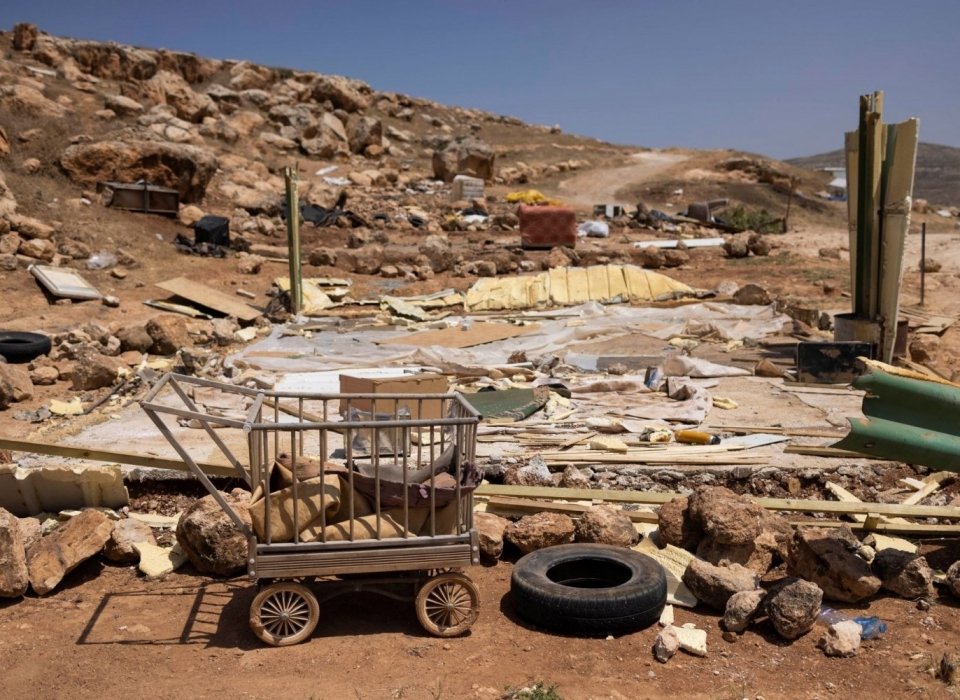
There are almost no Palestinians remaining in a vast area stretching east from Ramallah to the outskirts of Jericho. Most of the communities who lived in the area — which covers around 150,000 dunams, or 150 square kilometers, of the occupied West Bank — have fled for their lives in recent months as a result of intensifying Israeli settler violence and land seizures, backed by the Israeli army and state institutions. The near-total emptying of the region’s Palestinian population shows how Israel’s slow but gradual process of ethnic cleansing is continuing apace, effectively annexing large swathes of the occupied territory for exclusive Jewish settlement.
More than 10 settler outposts — which are illegal even under Israeli law, though the current far-right government is working hard to legalize them — have been established in this area over the past few years, with their settlers weaponizing shepherding as a means to take over Palestinians’ land and force them out. The few small Palestinian communities that remain in the area may also soon be forced to leave, out of grave fear for their physical safety and mental wellbeing. In the last year alone, hundreds of Palestinians have been forcibly displaced in this way.
To date, four Palestinian communities have been expelled from this region. In 2019, two groups of Palestinian families evacuated from the southern part of the area, near the Taybeh junction. In May of this year, the 200 residents of Ein Samia dismantled their own homes and fled following relentless settler violence. In July 2022, the 100-strong community of Ras a-Tin followed suit. In early August, the 88 residents of al-Qabun were forced to abandon their homes.
There are currently only three Palestinian communities left in the area: Ein al-Rashash, Jabit, and Ras Ein al-Auja. All of them are exposed to the same settler harassment that forced their former neighbors to flee.
This phenomenon is beginning to spill over to other Palestinian communities in adjacent areas. According to data collected by the UN Office for the Coordination of Humanitarian Affairs (OCHA) and the Israeli human rights group B’Tselem, 35 residents of the nearby village of Wadi a-Seeq recently packed up and fled, while the families that remain are facing heightened danger. In al-Baqa’a, 43 residents — the majority of the community — fled in July following the establishment of a new settler outpost and an arson attack on a house in the village.
According to Kerem Navot, an NGO that monitors developments on the ground in the West Bank, Israeli settlers have now effectively taken over an area between the Allon Road in the west, Route 90 in the east, Al-Ma’arjat Road near Taybeh in the south, and Route 505 near Duma in the north. This region includes Firing Zone 906 — designated across 88,000 dunams by the army in 1967 — around which most of the outposts have been established, and which was mainly used as a grazing area by Palestinian Bedouins. The remaining 60,000 dunams, between the firing zone and the Allon Road, is where these communities lived until they were forcibly displaced.
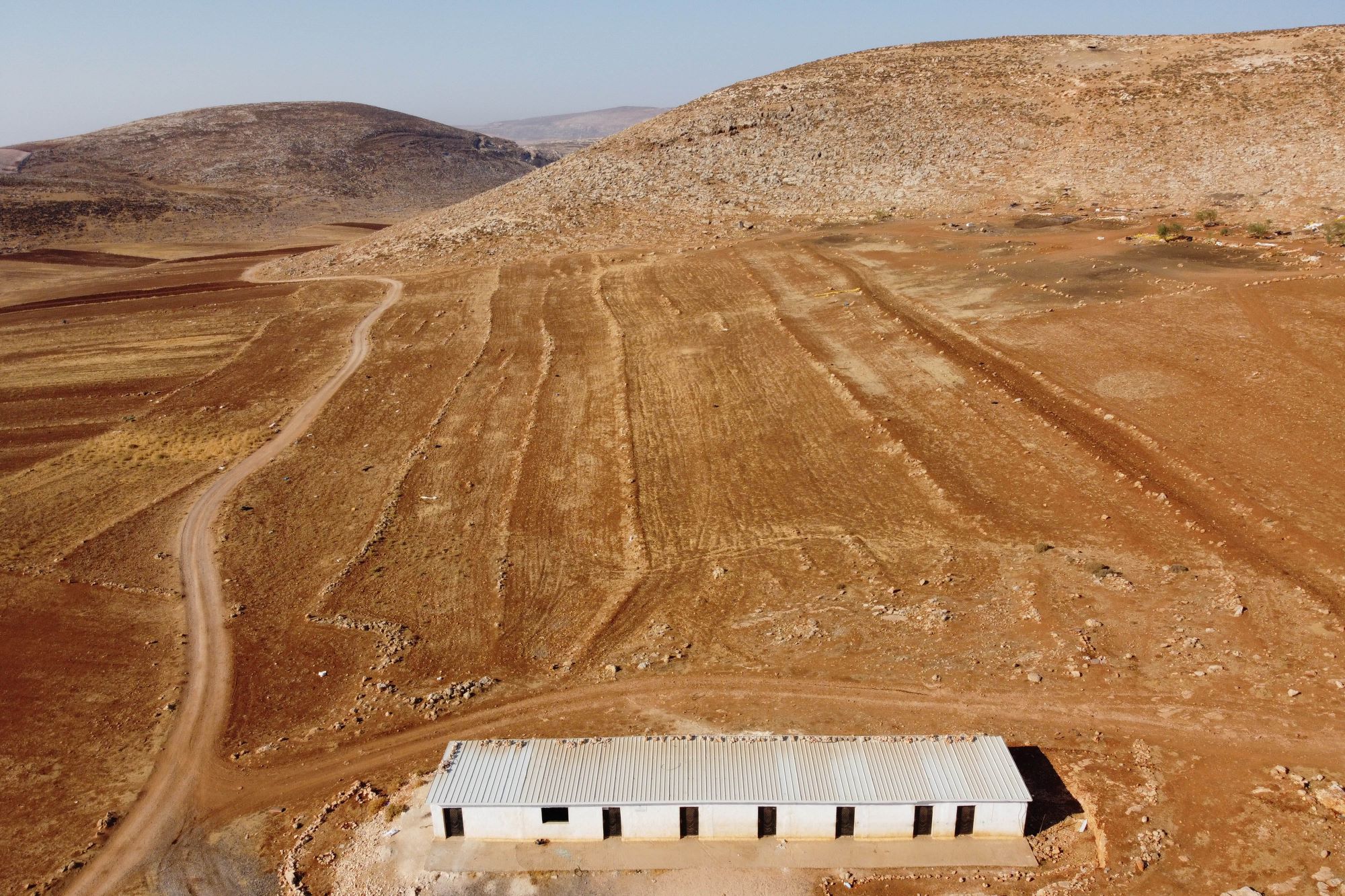
Aerial view of the area around al-Qabun school after the Palestinian community fled under the threat of Israeli settler violence, West Bank. (Oren Ziv)
All of this land is located in Area C, which is designated for Israeli civil and military control under the Oslo Accords. Some of it is privately owned by Palestinians, and other parts are deemed “state land” by the Israeli occupation authorities. Today, Palestinians only have access to about 1,000 dunams of this territory, and even those are prone to settler harassment and attacks.
Escalating settler violence
Technically, the ethnic cleansing of Palestinians from this area was not an official act of “transfer.” Neither the Israeli army nor the Civil Administration — the occupation’s bureaucratic arm — arrived with trucks, loaded the residents onboard, and destroyed their houses.
But they didn’t have to: in the face of unremitting settler violence and crippling restrictions by the Israeli authorities, the Palestinian residents felt that they had no choice but to flee. Some packed up their modest belongings, others left them behind. Largely agricultural communities, they relocated to areas where it would be more difficult for them to make a living, without pastoral land, but where they would at least enjoy temporary peace of mind.
Palestinians from several of the displaced communities described the same pattern to +972: Israeli settlers arrive with their herds and prevent them from grazing on land where Palestinians have grazed for decades; then armed settlers would proceed to harass them day and night, even entering houses, without the army or police intervening. Everyone described the same, overwhelming feelings of fear and distress under the shadow of these settler invasions.
“It’s like 1948,” said Mohammed Hussein, a resident of Ein Samia — invoking the year of the Nakba (“catastrophe”) and the expulsion of hundreds of thousands of Palestinians from their homeland during Israel’s establishment.
According to the Palestinian residents, the situation grew worse following the establishment and growth of several grazing settler outposts in the area in recent years; settler violence and further expansion also noticeably escalated since the current Israeli government, led by extremist far-right parties, was sworn in last December. According to UN OCHA, there were 14 settler attacks recorded in the area in 2019, 13 in 2020, and 14 in 2021. That number jumped to 40 attacks in 2022, and 29 settler attacks so far since the beginning of 2023. These numbers are likely an undercount, as not every case of violence has been documented.
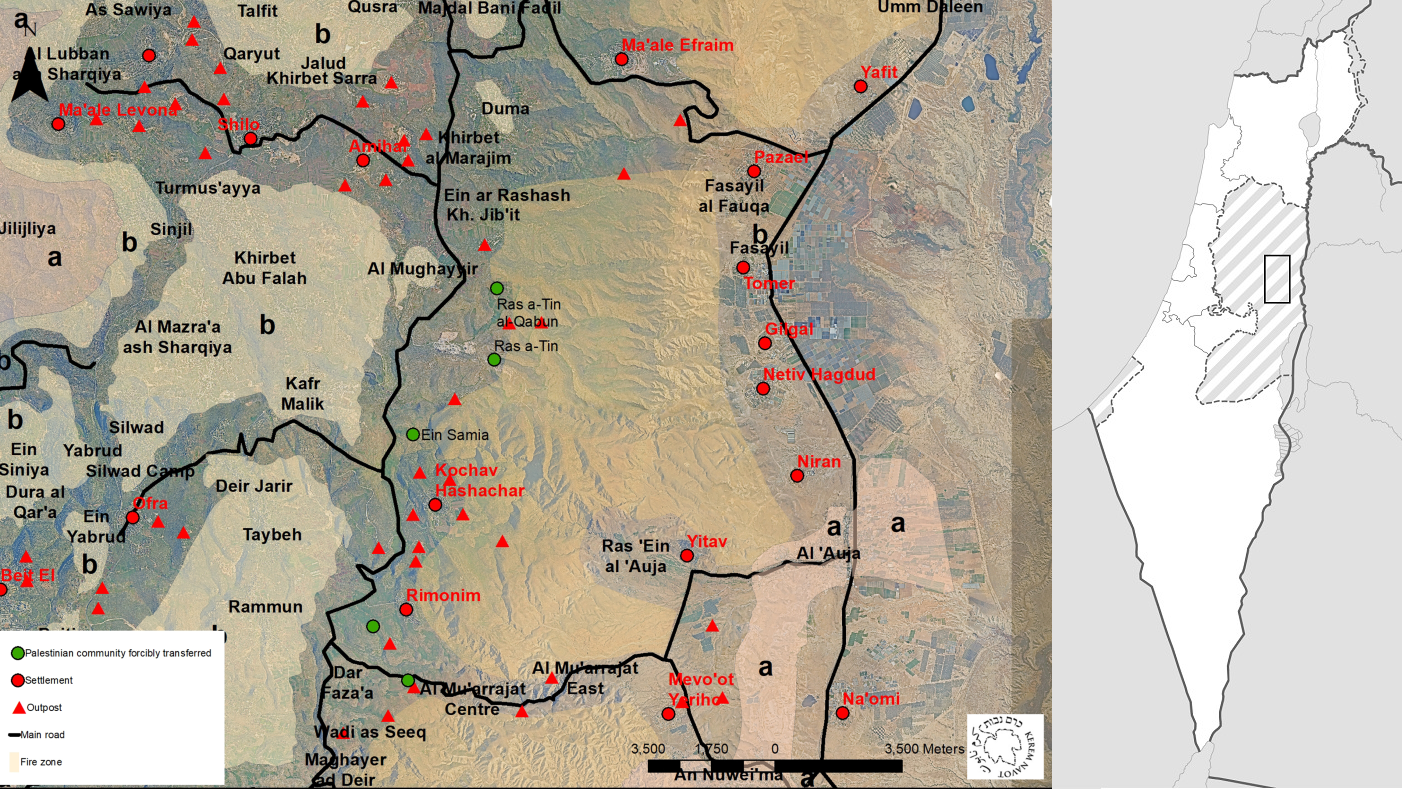
Map of the West Bank region in which most Palestinian communities have been forced out by Israeli settler violence and state policies. (Courtesy of Kerem Navot)
There is a clear correlation between the number of settler attacks and the gradual expulsion of Palestinians. In Ein Samia, for example, there were four reported attacks against the community in 2019. By May 2023, that number had gone up to 10 attacks since the start of the year alone. The same happened in Ras a-Tin (the UN defines Ras a-Tin and al-Qabun as one community); whereas there was only one attack in 2021, there were four separate attacks in 2022, compelling some residents to leave. Since 2023, there have been three reported attacks, pushing the rest of the community to leave entirely.
Moreover, according to UN OCHA, between 2019 and August 2023, one Palestinian was killed and another 132 were wounded by violence in the area; some were injured as a result of army or police activity during or after settler attacks. During the same period, soldiers or police officers killed two Palestinians and injured 230 during protests against surrounding settlements.
Many of the Palestinian families in the area are refugees from the Naqab/Negev desert inside what is today Israel, who in 1948 were expelled to the West Bank, and since 1967 have been expelled at least once more. Some arrived in this region in the late 1960s, after being forced out by the army from other places, while others arrived in the ‘80s or ‘90s. Most of the land they lived on is privately owned by Palestinians from nearby villages, who lease them the property.
The Israeli authorities, along with the settlers, have played a central role in the displacement. For years, the occupation apparatus has banned the Palestinian communities from construction; demolished their homes; denied them connection to water and electricity; stopped them from paving roads; issued demolition orders for schools built with funds from the European Union; established and recognized Jewish settlements; and, of course, stood by during settler violence.
‘The government is with them’
The latest Palestinian community to be expelled from the area was al-Qabun, established in 1996. It was made up of 12 families — 86 residents, 26 of them minors. Some of them moved west of the Allon Road, which bisects the West Bank from north to south, to land belonging to the village of Khirbet Abu Falah, while others left for other parts of the West Bank.
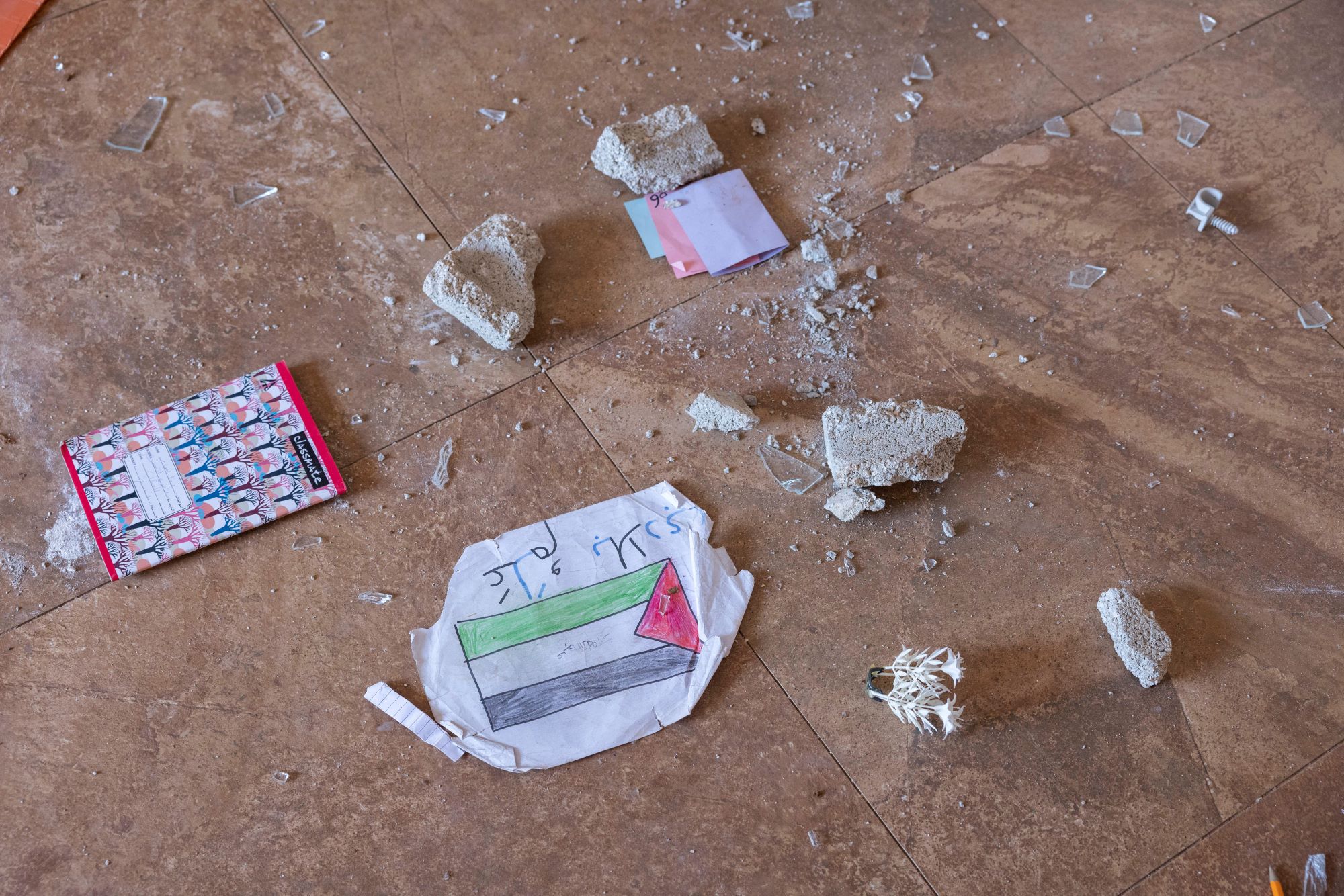
Drawings and remains at the school in al-Qabun, days after the Palestinian community fled in the face of Israeli settler violence, West Bank. (Oren Ziv)
In February, settlers established a new herding outpost near al-Qabun. Since then, settlers arrived on horses and tractors to provoke and frighten the Palestinian families, walking between their houses, while taking over their agricultural land and preventing them from grazing.
On a tour of the village’s location about 10 days after the expulsion, there were medicine bottles, dishes, and a water tank scattered across the ground — eerie remnants of an abandoned community. The school, built with European aid and subject to an Israeli demolition order, was also deserted, its windows smashed and contents looted. Several posters made by the children still hung on the walls.
“We have always been under occupation, in a prison with checkpoints, but now we live in a prison van,” said Ali Abu al-Kabash, 60, sitting in a tent he had set up in an open area across the Allon Road. Abu al-Kabash, who is originally from a-Samu, near Hebron, moved to the Ramallah area in the 1980s, and to the area near Ras a-Tin in 1995.
“Before the [last] election, the settlers would run away if there were a few of us [facing them]. Today, they attack because the government is with them. The police, the army, and the Shin Bet are all with them,” he added.
“For 25 years we lived a normal life,” Abu al-Kabash continued. “In recent years, the settlers came and established two outposts [Micah’s Farm and Malachei HaShalom]. They blocked the road between us and Ein al-Rashash, and the one that goes down toward Fasayil. We would herd in the area, but they came to us in the name of the government and the Civil Administration and said that the land belongs to the settlers. They brought sheep to eat the food we grew for our sheep … They enter houses, sometimes with many soldiers, taking photos, even when there are girls, women, and old men present.”
According to Abu al-Kabash, the violence increased after the Muslim holiday of Eid al-Fitr in May. “They park at the entrance of the homes. Some of them are under 12 years old, under the age of criminal responsibility. They go in, look in the refrigerator, or at our phones. What can we do? They want Area C for Israel, to take control of the land through the settlers, but without war. But where will we go? The occupation is everywhere.”
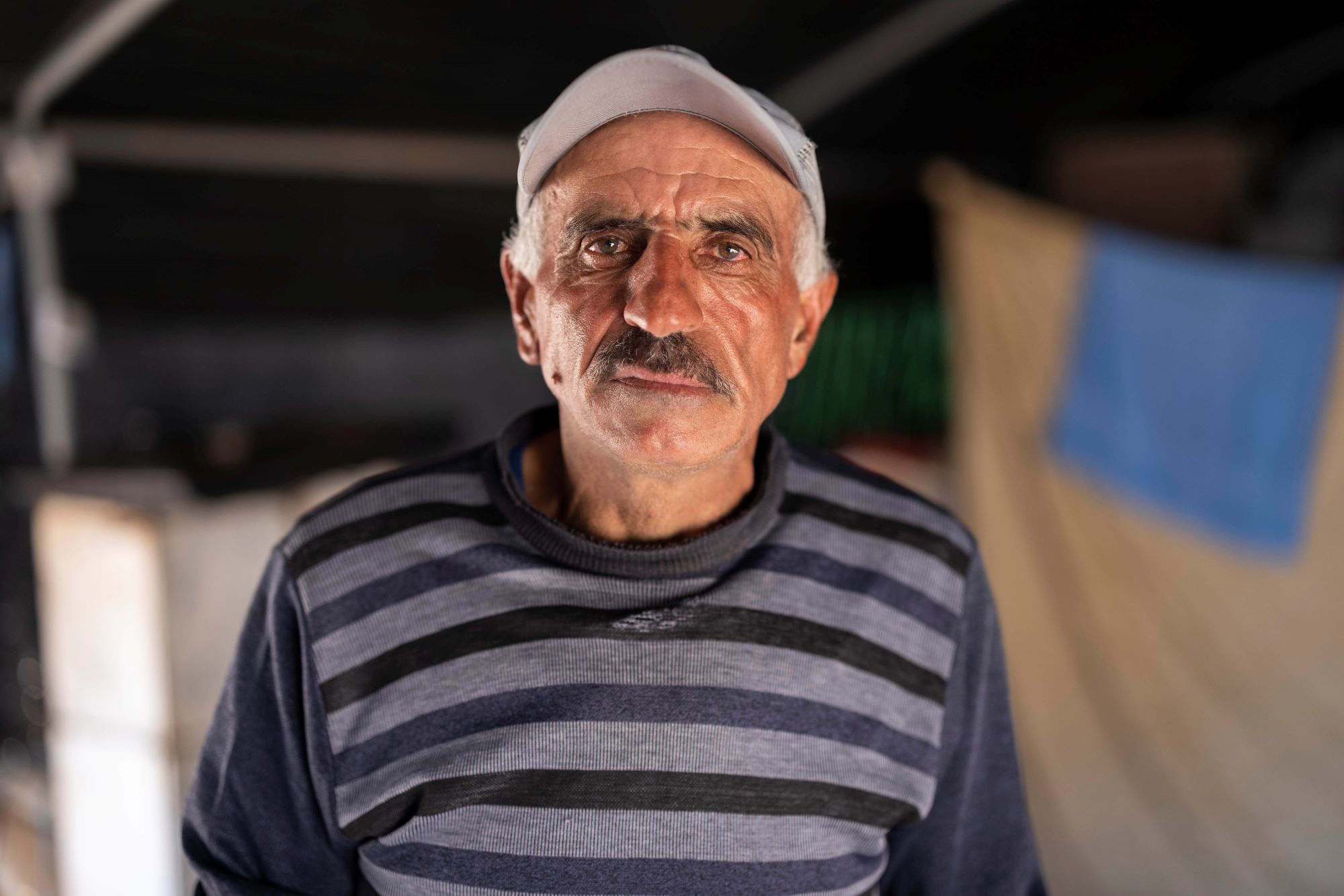
Ali Abu al-Kabash from the village of Al-Qabun, after the Palestinian community fled under the threat of Israeli settler violence, July 2023. (Oren Ziv)
Ras a-Tin, which neighbors al-Qabun, was subjected to similar harassment and severe violence by settlers. On the day its residents fled, in July 2022, Ahmad Kaabna, the mukhtar of Ras a-Tin — who died suddenly in early August at age 60 — told a group of activists: “The settlers frightened the women, the children — everyone. They came to the homes at night in groups of 10-15 people … the army with them. If you talk to them and say ‘get away, get out of here,’ they call the army or the police, who come and arrest the young [Palestinians].”
On July 14, 2021 — almost exactly a year before many families left, and two years before it was displaced entirely — the army, along with representatives of the Civil Administration, took over 49 structures belonging to the community, leaving 13 of the families homeless. The residents told UN OCHA that Israeli officials specifically ordered them to move to Area B of the West Bank.
‘It will not end here’
The residents of Ein Samia were driven from their homes in May, after five consecutive days of attacks. Like al-Qabun’s residents, some of them moved to land belonging to Palestinians living in Khirbet Abu Falah, while others moved to nearby towns and cities such as Deir Jarir, Taybeh, and Jericho.
“We have been living here for 44 years with the permission of the landowners,” said Hussein back in May as he packed his belongings in Ein Samia. “For years we have been here alone against the settlers, we have had no protection. In the last few days, settlers came and threw stones at the buildings. The children were very afraid. The goal was for us to leave. From 1948 until today we have lived in a continuous Nakba. Today it’s Ein Samia, but it will not end here.”
Two and a half months after the expulsion, Hussein and his family are still trying to rebuild their lives. They are now living in Area B, where the Palestinian Authority is responsible for planning, and where it is rare for Israel to carry out demolitions.
“I was born in Hebron but grew up in this area,” Hussein said. “We lived in Auja [in the Jordan Valley] until 1967, then the army came with tanks and gave us 24 hours to evacuate. We moved as a large group to Taybeh, near Ramallah, until they expelled us again and brought us here in the ‘70s.”
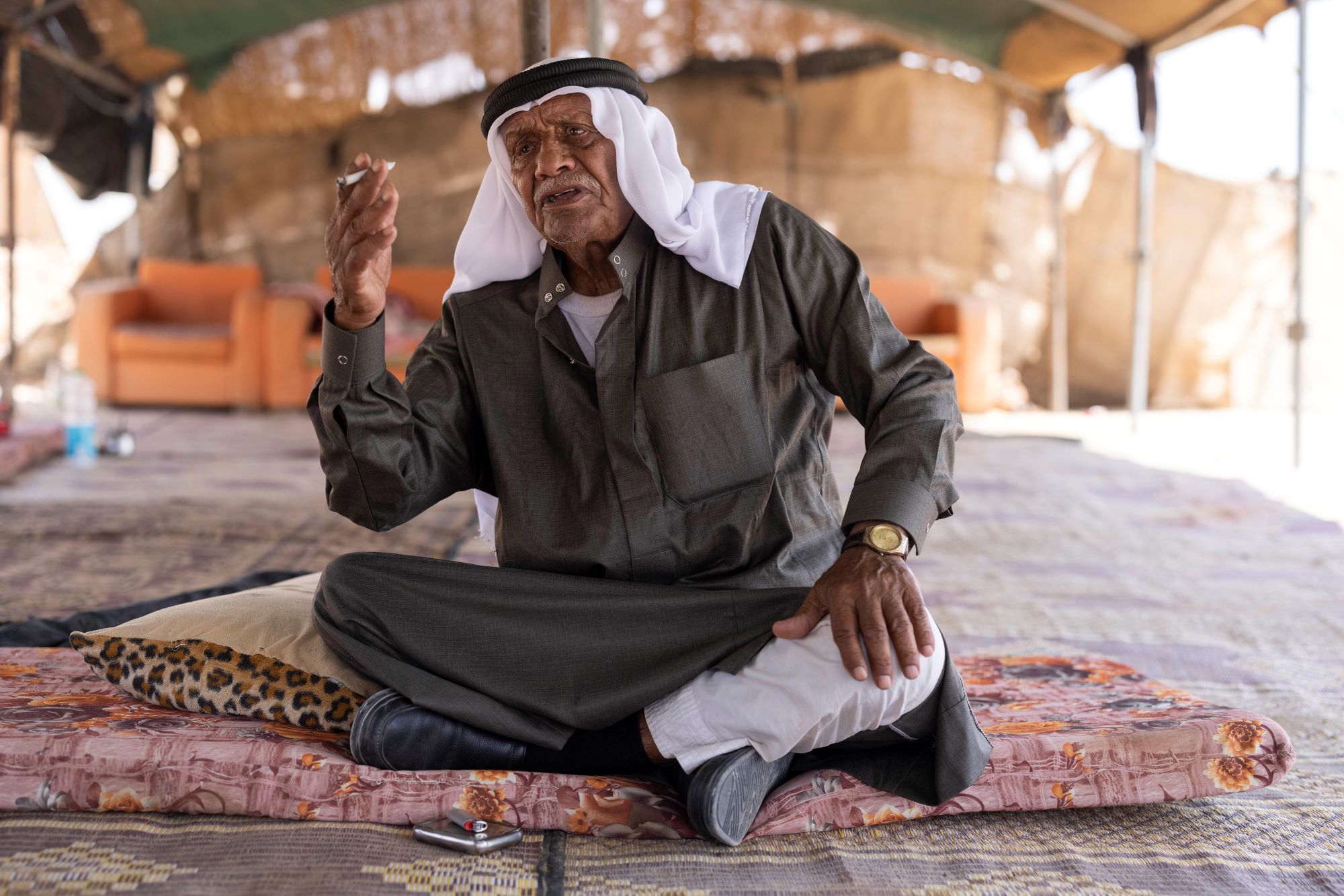
Mohammed Hussein, a resident of Ein Samia, after his family fled their village under the threat of Israeli settler violence, West Bank, July 2023. (Oren Ziv)
The residents lived there until the army set up a base nearby, when the residents were pushed once more to Ein Samia, where they lived until earlier this year. Over the years, they were harassed by the army, which confiscated their sheep. Then the settlers took the mantle.
“They come at night and throw stones when the children are sleeping,” said Hussein. “For five years we pleaded, but no one heard us. We used to call the police — they would come and the settlers would run away. In recent years, the police came and told us that we were lying.”
The final straw was in May, when armed settlers arrived in the dead of night and claimed that 37 of their sheep were stolen. They raided Ein Samia looking for their sheep, but could not find them. The next day, an Israeli police officer stopped a Palestinian shepherd from the village walking near the main road and confiscated his sheep, claiming they were stolen.
“We live off the sheep,” Hussein explained. “The army protects the settlers. Even if justice is on your side, they will imprison you for a week or two and take NIS 10,000 as bail.”
Hussein said the Israeli authorities and the settlers share the same goal: “Expulsion. They want no one to stay here. They want to expel all the Palestinians from the country, like they did in 1948. We lost everything. Families have been separated and scattered. The children don’t sleep there because of the settlers. There is safety here, but there is nothing to live from.”
On August 17, representatives from the Civil Administration, the army, and the Border Police arrived at Ein Samia’s abandoned school, destroyed it, and loaded the ruins and other remnants from the site onto trucks. Activists believe that the demolition was intended to prevent tours in the area by diplomats and journalists.
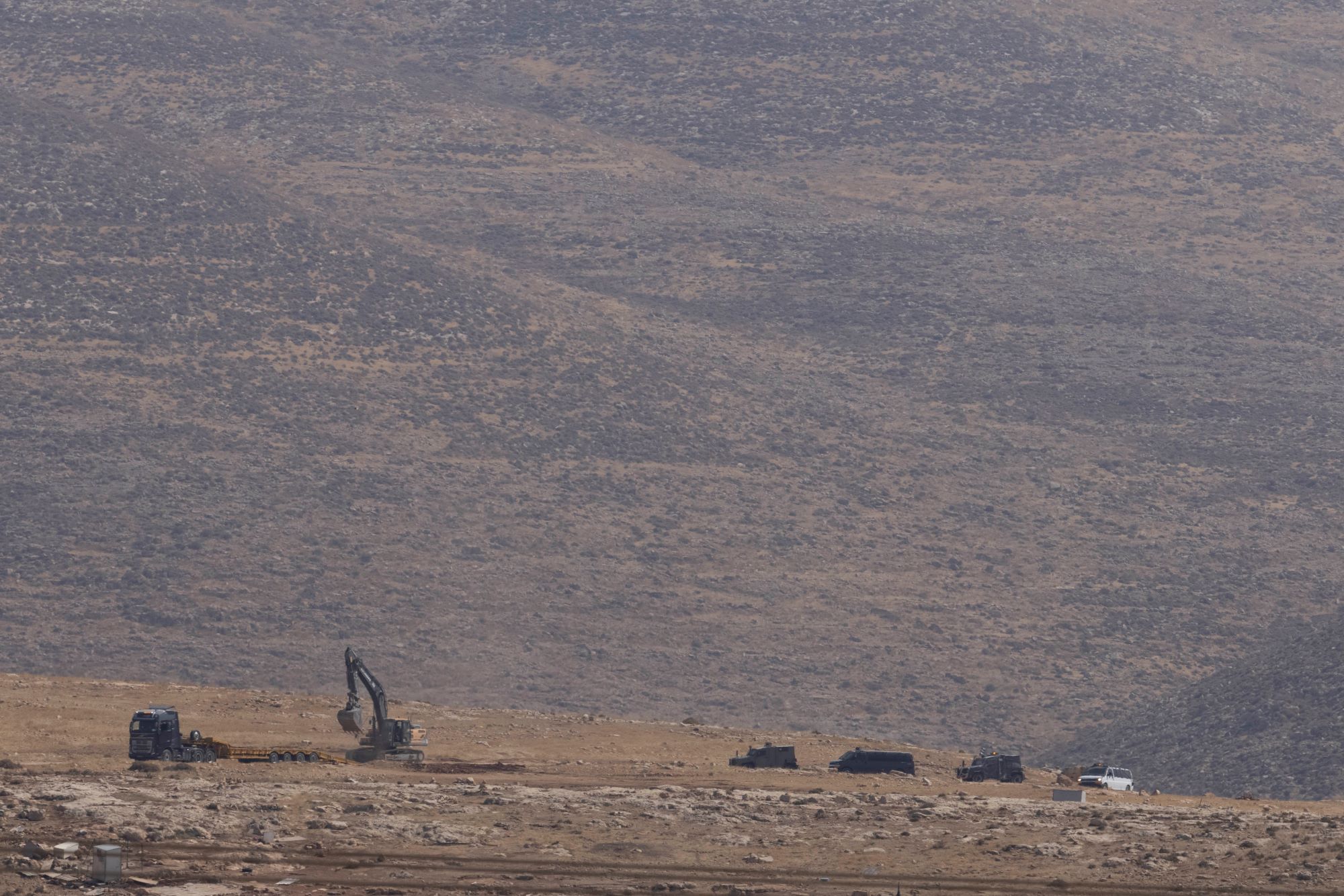
Israeli authorities demolishing the school at Ein Samia after the Palestinian community fled under the threat of settler violence, West Bank. (Oren Ziv)
The razing of the school was also carried out just a few days after a settler outpost in the area was demolished with the approval of Finance Minister Bezalel Smotrich — who is also the Defense Ministry official charged with overseeing the occupied territories — perhaps for the purpose of showing “balance.” Following the school’s demolition, Smotrich released a statement saying that “the State of Israel will not allow illegal construction and Arab takeover of the open areas.”
‘One farm guards thousands of dunams’
The flight of these Palestinian communities is part-and-parcel of Israel’s colonization of the occupied territory. In this particular region, the process is centered around the settlement of Kochav HaShachar and its various outposts, which have been springing up over the past few decades.
Some of these outposts move around, are evacuated by Israeli authorities from time to time, and then re-established. Yet they have all, by various means, contributed to the gradual settler takeover of the area, whether through the establishment of farms, vineyards, the blocking of Palestinian roads, or the sight of caravans as new satellite outposts.
Kochav HaShahar was established in the late 1970s, and is today home to approximately 2,500 Jewish Israelis. In the 1990s, the outposts of Ma’ale Shlomo and Mitzpe Kramin were created. In 1998, Kochav HaShahar’s gate was moved a few miles west, blocking the agricultural area around the settlement, and consequently access to thousands of acres of Palestinian land.
Over the next 20 years, settlers built a number of additional outposts surrounding Kochav HaShahar, including Baladim, Maoz Esther, and Ma’ale Ahuviya. In 2004, Einat Kedem was established in the southeast, close to Jericho. Malachei HaShalom was built in 2014 in a partially abandoned military area, just east of the settlement of Shiloh, the first in a series of outposts established to the east. In February of this year, the Israeli government decided to formalize the outpost, turning it into an official settlement.
Neriya’s Farm, a herding outpost owned by Neriya Ben Pazi, was established in 2018 south of the Rimonim settlement, and has taken over thousands of acres of land. It has several subsidiary outposts, including two in the direction of Jericho: Zohar’s Farm, and an outpost established in memory of Harel Masood, one of four victims of a shooting attack in the settlement of Eli in June.
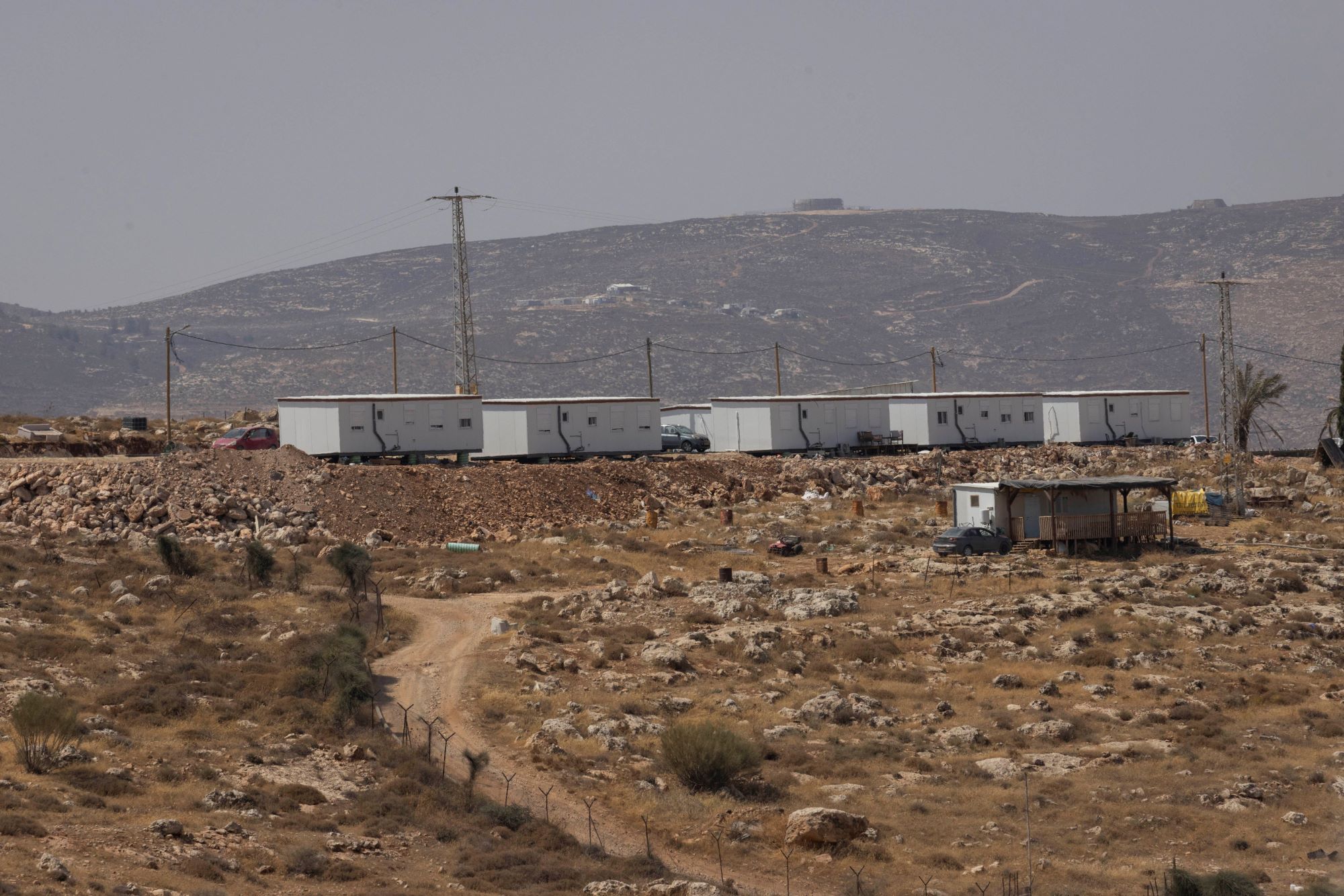
The settler outpost of Malachei Hashalom in the West Bank. (Oren Ziv)
Another outpost, Micah’s Farm, which was established in 2018 at the foot of Kochav HaShachar overlooking Ein Samia, relocated in 2020 close to the now depopulated village of Ras a-Tin. The army then prevented the Palestinian villagers from crossing the Allon road to access their own lands. Palestinians in the nearby villages of Al-Mughayyir and Kufr Malik organized protests following the outpost’s relocation.
Israeli settlers and soldiers have killed three Palestinians in Al-Mughayyir in the past few years. In July 2022, a settler shot and killed 16-year-old Amjad Abu Alia; in December 2020, during a Friday demonstration, an army sniper shot 15-year-old Ali Abu Alia in the stomach, killing him; and in January 2019, during an attack on the village by armed settlers, 38-year-old Hamdi Na’asan, a married father of two, was shot in the back and killed.
In 2020, settlers founded the Rashash Farm outpost northeast of Malachei HaShalom, along the border of Firing Zone 906. A vineyard was recently established south of Malachei HaShalom, and a tent was placed on a road that Palestinian farmers use to reach grazing lands in an area known as Dalia, but the settlers now prevent them from using it. Several new outposts were also established around existing outposts, some of which were evacuated and then repopulated.
In this same area, there are also settlements close to Route 90, including Yitav, Na’aran, Gilgal, Tomer, and Petza’el, home to around 1,300 settlers altogether.
“The settlers have managed to create an area of tens of thousands of dunams, which were used as grazing land by the communities that were expelled, and are today empty of Palestinians,” explained Kerem Navot’s Dror Etkes, citing Firing Zone 906 as an example. “For the settlers, this [takeover] is a very significant achievement, which they are trying to reproduce elsewhere.”
Indeed, according to data from Kerem Navot, as of last year, settlers have taken control of approximately 238,000 dunams of the West Bank under the pretext of agriculture and grazing. In a speech at an online conference hosted by the Amana settler organization in 2021, the group’s CEO Ze’ev (Zambish) Hever explained the logic behind this method: “Construction [alone] takes up little space, due to economic considerations. We reached 100 square kilometers after more than 50 years. [Farm outposts] have more than twice the area of built-up settlements … One farm guards thousands of dunams of land.”
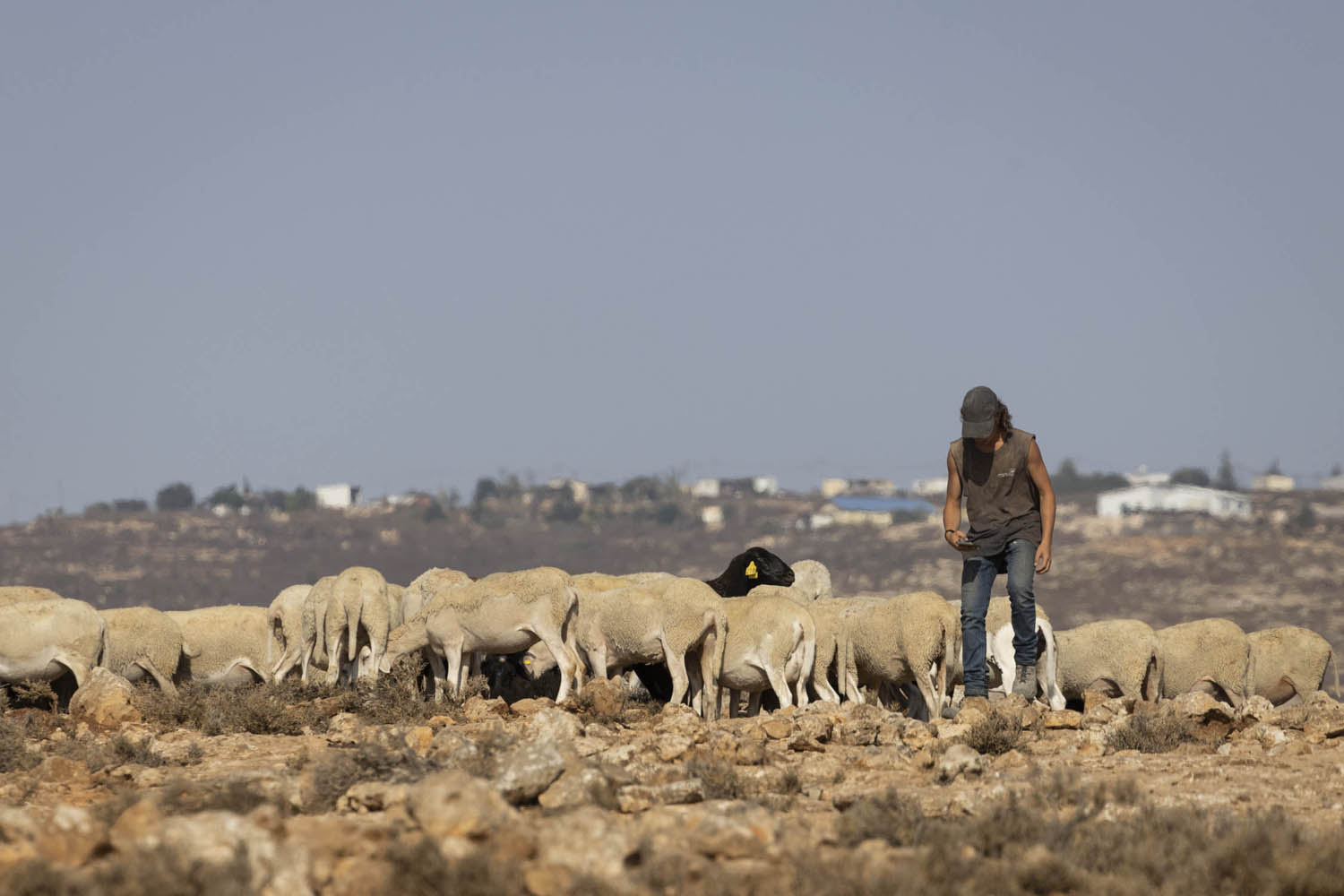
Israeli settler with grazing sheep near the Palestinian village of Ein al-Rashash. (Oren Ziv)
‘The border moves every month’
Following the exodus of the past few months, the Palestinian community of Ein al-Rashash, made up of 18 families totaling just under 100 residents, is now bearing the brunt of Israeli settler violence, with the nearby outposts of Malachei HaShalom and Rashash Farm preventing the residents from grazing their sheep.
“From here to Fasayil and Auja, there is nobody,” said resident Eid Salama Zawara. “We lived here for almost 30 years in peace. Four years ago, they established the outpost, and then everything changed. At first, the settlers said: ‘This is the border, I will graze here and you there.’ But the border moves every month, and now they are already arriving at the doorstep of our homes with their sheep, going inside them, and we can’t go out.”
Gesturing to the surrounding hills, he added: “There is room here for all the sheep in Israel and the West Bank to graze. But they [the settlers] don’t want anyone else to graze here.”
A significant attack occurred on June 24, when several settlers entered the village and then called for reinforcements. “After that, the army came,” said Zawara. “We calmed down, because we thought they would protect us, but that didn’t happen. The soldiers dispersed the young people with [tear] gas and rubber [bullets], and at the same time settlers broke windows, smashed solar panels, and started setting fire to a house.
“They beat an old man with a stick, and broke the radio he listens to every day,” Zawara continued. “The soldiers stood aside. A police officer arrived and took a photo of the wounded man, but they arrested three young [Palestinian] men from the village.”
The elder who was assaulted, Haj Salama, told +972: “Since the attack, I’ve been afraid. I don’t sleep at night. I get scared every time a car passes by.”
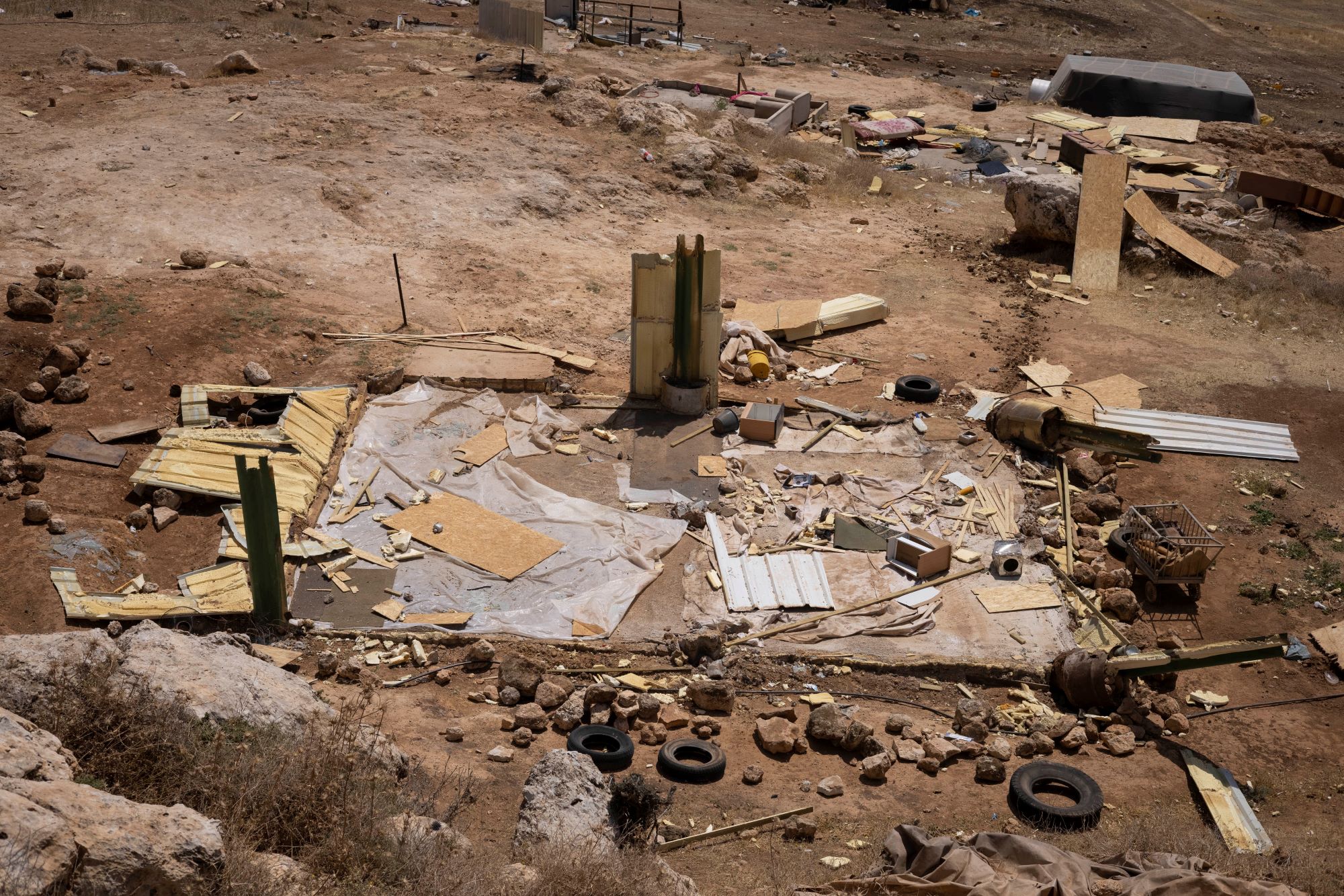
The belongings and remains of homes of Palestinian families in Ein Samia, West Bank. (Oren Ziv)
Zawara is certain that the settlers are intending a similar fate for Ein al-Rashash as that which befell the now depopulated neighboring villages. “They want us to move somewhere else, but everywhere we go there are more settlers — so where do we go?”
Residents of al-Ma’arajat are facing similar challenges nearby. Elia Maliha, a 28-year-old communications student from the community, told +972: “Fifty families have lived here for 40 years. We get water in tankers, the houses are made of tin sheets, and most of them have been demolished [by the authorities] in the past. A demolition order was also issued for the school. The children who finish 12th grade go to study at university or college, but the livelihood here is all from the herds.
“People here love animals and want to live in peace,” she continued. “In the last two years, since the outpost was established, life has changed. The settlers are throwing carcasses in grazing areas, entering houses night and day, opening cupboards and spilling their contents, rummaging through the refrigerator, and more … But we have strength and courage, we’re staying, and with the help of steadfastness, we don’t want to become al-Qabun or Ein Samia.”
On July 27, two jeeps with masked Israeli soldiers entered the community and searched the houses. Two days later, an armed settler came, accompanied by soldiers. “They claimed that something was stolen from them, and they wanted to conduct a search,” Maliha recounted. A video from the incident shows an armed settler entering residential tents and sheep pens, with soldiers guarding him and silencing Palestinians who demanded that he leave.
Two other communities southward are also in danger. One is al-Baqa’a, home to 33 people including 21 minors. On July 10, most of the community fled following weeks of attacks by settlers; days earlier, settlers had burned down one of the structures belonging to a family that had temporarily left due to the violence. After the exodus, the Civil Administration demolished the nearby settler outpost, but it has since been rebuilt. Nearby, in the community of Wadi a-Seeq, the residents fear that they are next in line; some of them have already fled.
‘The whole system is being mobilized for the settlers’
“This is not a 16-year-old boy deciding on his own what to do,” Etkes explained about the settler outposts. “People plan and think about where and what to build. There is legal support, money, experience, and motivation. And right now the political conditions are a dream. They’re exploiting this opportunity [while] at the height of their power. This would not be happening without the support of the most instrumental entities on the ground, such as the regional councils, Smotrich’s settlement administration, [and] the Civil Administration.
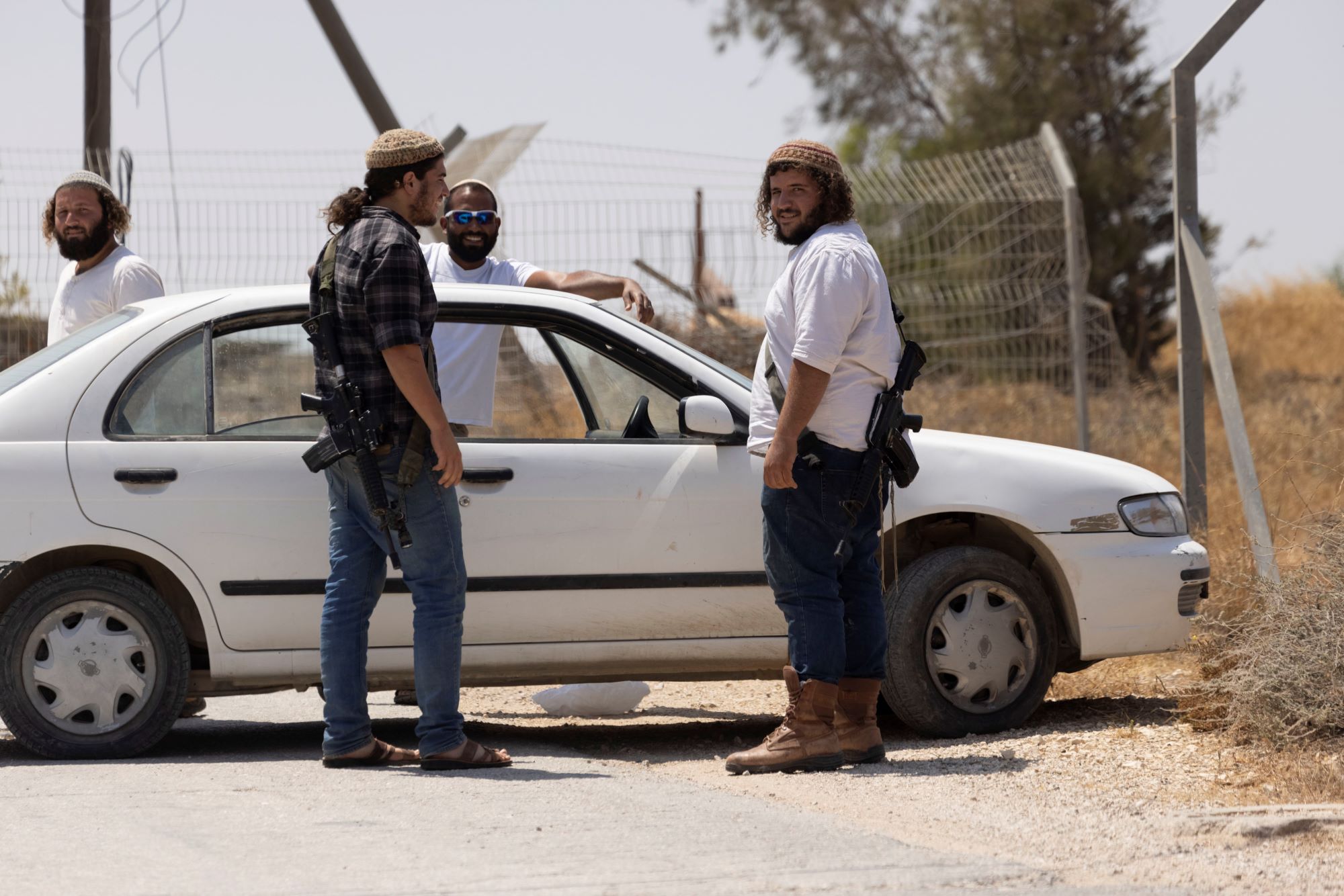
Armed Israeli settlers near the outpost of Malachei HaShalom, West Bank. (Oren Ziv)
“We haven’t seen such boldness before, coming into communities and attacking inside people’s homes,” Etkes continued. “The whole system is being mobilized in order to allow settlers to take over several thousand dunams.”
According to a report on Israel’s Channel 12, Smotrich is advancing a takeover plan for Area C, which includes legalizing and expanding outposts that have already been established, and building new ones. On August 20, for example, the government decided to allocate land to the Mevo’ot Yericho outpost, close to the area discussed above, which was formally recognized in 2019.
The expulsion of residents appears to be part of the “Battle for Area C,” a campaign announced by Israeli right-wing groups and politicians several years ago. Settler organizations have long made a concerted push to prevent Palestinian development in Area C, which comprises 60 percent of the West Bank and is home to most of its open and agricultural land — and all of the settlements. Israel’s full security and administrative control over Area C means that any Palestinian construction needs Israeli approval, which is almost never granted.
Israeli governmental and non-governmental bodies alike have been steadily making their case for the continued takeover of Area C. In June 2021, the Intelligence Ministry published an extensive report in which it discussed the 2009 “Fayyad Plan” — named after Salam Fayyad, the Palestinian prime minister at the time — which included a program to assert control over Area C and acquire European support for the Palestinian communities there.
A report a couple of months later from Regavim, a far-right settler group co-founded by Smotrich, claimed that the building of schools was part of a Palestinian plan to control Area C. Last year, Israel’s Settlement Ministry transferred around NIS 20 million to local Israeli councils in Area C, to be used for gathering intelligence on Palestinian construction in the region.
In 2017, Smotrich published his “Decisive Plan” for taking over the West Bank; although the document does not mention Area C, he wrote that Israel must take action to realize “our national ambition for a Jewish state from the [Jordan] river to the [Mediterranean] sea.”
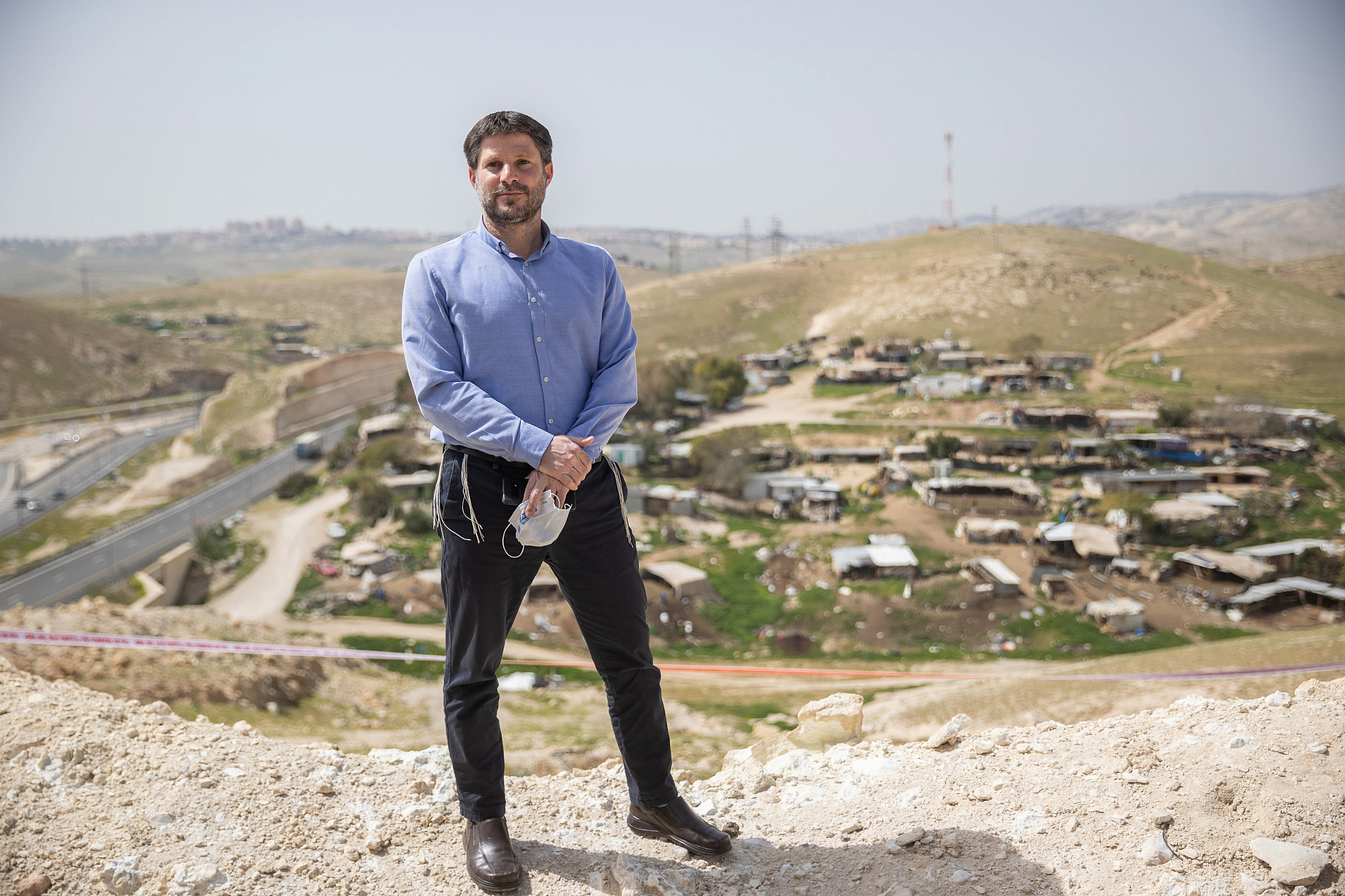
Religious Zionism Chairman Bezalel Smotrich stands above the Palestinian Bedouin village of Khan al-Ahmar, West Bank, March 21, 2021. (Yonatan Sindel/Flash90)
Doing so, Smotrich stressed, would require “a political-legal act of imposing sovereignty on all Judea and Samaria [the Biblical name for the West Bank]” while simultaneously establishing new cities and towns; further developing infrastructure to be on a par with that inside the Green Line; and encouraging “tens or hundreds of thousands” of Israelis to move to the West Bank. “In this way,” he argued, “we will be able to create a clear and irreversible reality on the ground.”
Although the idea of official Israeli annexation was temporarily shelved in 2020, in practice the authorities and settlers alike have been implementing it in areas where Palestinian communities have been forcibly displaced.
Alon Cohen-Lifshitz, an urban planner with the NGO Bimkom, which works with communities in the area, said: “The real threat is not the demolition orders, but settler violence. Of the 50 communities we looked into in the area, 20 are most at risk, and some have already left. The state has been trying to ‘clean up’ the area since 2014, without success — procedural, diplomatic, and legal measures have prevented it.
“Now the state has gone from actively trying to deport [Palestinians] to passively ignoring the actions of the settlers,” Cohen-Lifshitz continued. “It’s much more convenient, and more successful.”
A number of Israeli and international activists have been going to the area regularly for years, and are trying to stand with the Palestinian residents against the settlers. Rabbi Arik Ascherman, one such activist, described Israeli policy like this: “Everywhere there are three strikes: threats and violence; economic damage caused by preventing [shepherds] from accessing grazing land; and backing from the state — by demolitions and confiscations, and unwillingness to offer any protection.
“The police told me that there is nothing legally prohibiting settlers from walking around next to [Palestinians’] houses or even inside tents,” Ascherman continued, warning: “If we don’t do anything, more and more communities will leave. We need to be physically present on the ground.”
The IDF Spokesperson declined a request for comment.
A version of this article was first published in Hebrew on Local Call. Read it here.
Oren Ziv is a photojournalist, reporter for Local Call, and a founding member of the Activestills photography collective.
LATEST OPEN LETTERS
-
21-07Freedom
-
20-03Stand up to Trump
-
18-02Average Americans Response
-
23-12Tens of thousands of dead children.......this must stop
-
05-06A Call to Action: Uniting for a Lasting Peace in the Holy Land
-
28-05Concerned world citizen
-
13-02World Peace
-
05-12My scream to the world
-
16-11To Syria and Bashar al-Assad
-
16-11To Palestine
VIRTUAL POST OFFICE
PETITIONS
LINKS
DONATION
Latest Blog Articles
-
17-12Our Wednesday News Analysis | Gaza and the unravelling of a world order built on power
-
16-12Gaza and the unravelling of a world order built on power
-
16-12US plan in Gaza: forced ghettoisation, annexation, mass detention, resource plunder
-
16-12Von der Leyen and Blair still want to boss Palestinians around
-
15-12The Evangelical Pope | The Universal Value of Life
-
11-12Our Friday News Analysis | What the World Reads Now!
-
10-12Our Wednesday News Analysis | A story of a 1930s uprising against British colonialism is key to understanding Gaza today
-
09-12A story of a 1930s uprising against British colonialism is key to understanding Gaza today
-
09-12Netanyahu rules out creation of Palestinian state
-
09-12Israel has shown how to carry out a genocide and get away with it
-
08-12The Evangelical Pope | Humility – the Power of Truth and Love
Latest Comments
 One of the most important and illuminating articles that I …
One of the most important and illuminating articles that I …
Comment by Benjamin Inbaraj And what's wrong here?
After all, there is the homeland …
And what's wrong here?
After all, there is the homeland …
Comment by Isac Boian Does this reinforce or deny my argument that Israel is …
Does this reinforce or deny my argument that Israel is …
Comment by Edward Campbell Many 'say' they support the Palestinian cause but do little …
Many 'say' they support the Palestinian cause but do little …
Comment by Philip McFedries The UN is strangled by the "war for profit" cabal …
The UN is strangled by the "war for profit" cabal …
Comment by Philip McFedries I can't read the printing on the map.
I can't read the printing on the map.
Comment by Philip McFedries Good news!
Good news!
Comment by Philip McFedries

COMMENTS
This article has 0 comments at this time. We invoke you to participate the discussion and leave your comment below. Share your opinion and let the world know.